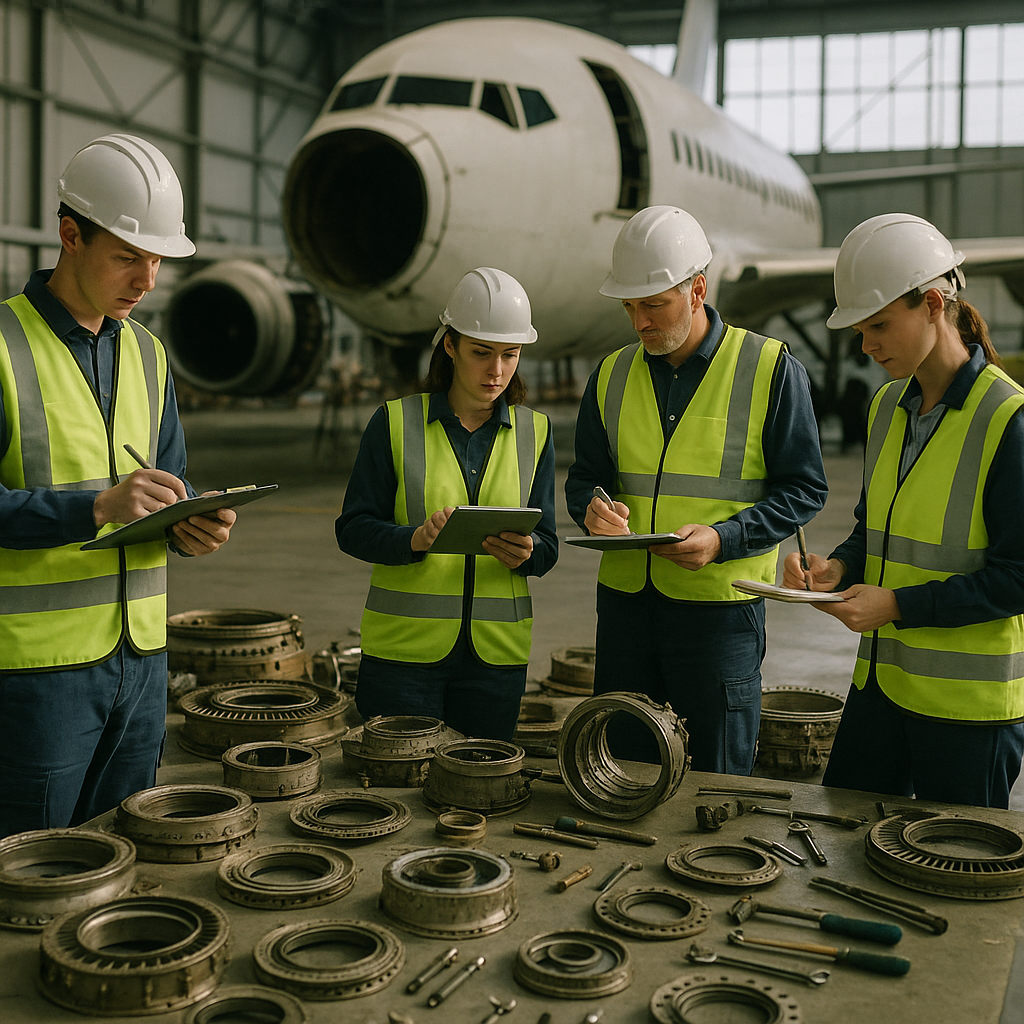5901 Botham Jean Blvd, Dallas, TX 75215
What is Asset Recovery for Surplus Aerospace Parts?
July 31, 2025Did you know the aerospace industry generates millions of dollars in surplus parts inventory annually? Asset recovery transforms these idle components into immediate cash flow for aerospace companies. The process involves systematically evaluating, marketing, and selling excess aircraft parts that are no longer needed for operations.
Asset recovery programs deliver three key benefits to aerospace organizations: they free up valuable warehouse space otherwise used to store dormant inventory, generate significant revenue from components that might otherwise depreciate, and improve bottom-line performance by converting stagnant assets into working capital.
A comprehensive asset recovery strategy typically includes market assessment of part values, connection to global buyer networks, and expert valuation of aerospace components. These elements ensure organizations maximize returns on their surplus inventory rather than accepting steep discounts or allowing parts to sit idle.
How Does the Aerospace Asset Recovery Process Work?

The aerospace asset recovery process follows a structured methodology to maximize the value of surplus parts and materials. This process begins with a comprehensive inventory assessment where experts evaluate each component for marketability, condition, and potential value in the secondary market.
After assessment, specialized recovery firms use their industry networks to locate potential buyers. This phase involves tapping into global connections across commercial aviation, business aviation, and MRO (Maintenance, Repair, and Operations) sectors to find suitable matches for each asset.
Core Steps in Aerospace Asset Recovery
The recovery process includes several critical stages that ensure efficiency and maximum value recovery. Each step demands specific expertise and careful attention to detail.
- Initial inventory assessment – Evaluating the condition, marketability, and value of surplus parts
- Documentation preparation – Compiling detailed records of parts, including serial numbers and specifications
- Network activation – Engaging industry contacts to identify potential buyers
- Marketing and listing – Presenting assets through appropriate channels to attract qualified buyers
- Negotiation and transaction – Securing optimal pricing and managing sales agreements
- Logistics coordination – Arranging transportation and delivery of components
Throughout this process, asset recovery specialists maintain detailed tracking systems, often utilizing sophisticated logistics management software to provide real-time updates on asset status. This tracking ensures an unbroken chain of custody and full accountability from start to finish.
Logistics and Transportation Solutions
The physical movement of aerospace assets requires specialized logistics expertise, often including door-to-door services, counter-to-counter delivery, and expedited options like Next Flight Out when timing is crucial.
For hazardous materials or sensitive components, certified logistics providers ensure compliance with International Air Transport Association (IATA) regulations, which is essential for aerospace parts that may contain hazardous materials or require special handling procedures.
Advanced tracking technologies play a pivotal role in the transportation phase. GPS capabilities monitor transit times and can provide alerts about potential delays, allowing for quick rerouting if necessary to maintain delivery schedules.
The comprehensive nature of professional asset recovery services enables aerospace companies to focus on core operations. By outsourcing the complex process of surplus asset management, organizations can recover maximum value from their inventory while maintaining operational efficiency.
What Are the Key Benefits of Aerospace Asset Recovery?
Aerospace asset recovery offers substantial financial and operational advantages for companies aiming to optimize their resources. When implemented effectively, this strategic approach transforms idle or end-of-life assets into valuable opportunities for cost reduction and revenue generation.
Cost reduction is one of the most immediate benefits of aerospace asset recovery. Storage facilities for aerospace components are specialized environments with controlled temperature, humidity, and security requirements, typically costing $15-25 per square foot monthly. This creates significant overhead for companies storing unused parts. By recovering and redistributing these assets, companies can substantially reduce their warehousing footprint and associated costs.
Space optimization complements cost reduction. Aerospace manufacturing and maintenance facilities operate with limited space that must be maximized for productive activities. Removing obsolete or surplus inventory frees up valuable floor space that can be repurposed for revenue-generating operations. For instance, a major aircraft manufacturer recently recovered over 10,000 square feet of premium space by implementing an asset recovery program for outdated avionics components.
Revenue generation is another significant benefit of aerospace asset recovery. Parts no longer serving their original purpose can often be refurbished or recycled, creating new revenue streams from what would otherwise be waste. Even components from decommissioned aircraft retain significant value in secondary markets. The aluminum from a single commercial aircraft can be worth tens of thousands of dollars when properly recovered and recycled.
Improved inventory management results from the systematic evaluation and categorization of assets during the recovery process. This increased visibility helps companies maintain optimal stock levels, reduce emergency purchases, and prevent production delays. Asset recovery specialists use sophisticated inventory management systems to track parts throughout their lifecycle, ensuring nothing of value gets overlooked or misplaced.
Write-off reduction provides a notable financial advantage. When aerospace companies recover value from assets previously designated for write-off, they improve their financial statements and tax positions. This recovery directly impacts the bottom line and helps justify the initial investment in specialized equipment or materials.
Sustainability benefits extend beyond financial advantages. The aerospace industry faces increasing pressure to reduce its environmental footprint. Asset recovery significantly contributes to these efforts by extending the useful life of components through reuse and recycling. According to industry reports, each ton of aerospace-grade aluminum recycled saves approximately 14,000 kWh of energy compared to mining and processing new materials. This energy saving translates to a reduction of about 9 metric tons of carbon dioxide emissions.
Access to specialized expertise is a critical benefit when working with asset recovery professionals. These specialists understand the complex regulatory requirements governing aerospace parts and materials. They can navigate the certification and documentation necessary for remarketing components in the highly regulated aerospace sector. Their global market connections also help companies access a wider pool of potential buyers, maximizing the recovered value of the assets.
Risk mitigation is another important advantage. Proper disposal of aerospace components often involves complex environmental and safety considerations. Asset recovery specialists ensure compliance with all relevant regulations, reducing the risk of fines or legal issues associated with improper disposal. They also protect sensitive technologies through secure destruction processes when needed.
Operational efficiency improves as companies embrace asset recovery as part of their regular business practices. By integrating asset recovery into standard procedures, companies can streamline management of the complete lifecycle of aerospace components, reducing the administrative burden and allowing greater focus on core business activities.
No table output available
How to Choose an Asset Recovery Partner for Aerospace Parts?

Choosing the right asset recovery partner for aerospace parts requires careful evaluation. The specialized nature of aerospace components demands a partner with industry-specific knowledge and capabilities. These assets often represent significant capital investments and contain valuable materials that can be highly profitable when recovered properly.
Industry experience is a crucial factor when selecting an asset recovery partner. Aerospace components have unique characteristics, regulatory requirements, and market dynamics that differ significantly from other industries. Partners with specific aerospace expertise understand these nuances and can navigate the complex landscape of regulatory compliance while maximizing recovery value.
Evaluate Industry Expertise and Experience
Look for a partner with verifiable experience working with aerospace materials and components. Their team should demonstrate knowledge of aircraft part lifecycles, airworthiness standards, and the specific challenges of handling aerospace inventory. Companies that understand aerospace parts’ unique nature can more effectively assess their value and find appropriate markets for resale or recycling.
A partner’s track record is equally important. Request case studies or references from other aerospace clients they’ve served. This will help verify their capabilities and results in similar recovery situations. The aerospace industry faces unique challenges in asset recovery, including strict compliance requirements and specialized markets for components.
Assess Global Reach and Buyer Networks
The market for aerospace parts is global. A recovery partner should have established networks that extend beyond local boundaries to access international buyers and maximize recovery value. This global reach allows them to match specialized components with appropriate markets worldwide.
Strong buyer networks are essential for obtaining competitive prices for recovered assets. Partners with established relationships in the aerospace sector can connect your surplus parts with buyers who understand their value. Ask potential partners about their buyer network size, the types of buyers they work with, and their process for matching assets to appropriate purchasers.
Examine Transparency and Sales Process
Transparency throughout the recovery process is crucial. Your partner should provide clear documentation and reporting at every stage. This includes detailed inventory assessments, valuation methods, marketing strategies, and final sales reports. Transparency builds trust and ensures you receive fair value for your assets.
The sales process should be structured to maximize returns while meeting your timeline requirements. Some partners offer multiple selling methods, including private treaty sales, online auctions, or consignment arrangements. Understanding these options and how they align with your recovery goals is important for success.
Evaluate Comprehensive Service Offerings
Effective asset recovery requires more than just selling parts. Look for partners offering end-to-end services, including:
- Inventory assessment and valuation
- Asset remarketing strategies
- Logistics management
- Documentation and compliance handling
- Environmentally responsible recycling for non-recoverable items
These comprehensive services relieve your team while ensuring nothing falls through the cracks during the recovery process.
Verify Compliance and Regulatory Knowledge
Aerospace is a highly regulated industry. Your recovery partner must demonstrate thorough knowledge of regulations governing the sale and transfer of aerospace parts. This includes understanding requirements from aviation authorities worldwide, export controls, and documentation standards.
Compliance failures can lead to significant penalties and reputation damage. Partners should have established processes for maintaining proper documentation and ensuring all transactions meet regulatory requirements.
No table output available
Consider Financial Stability and Business Practices
The financial stability of your recovery partner matters. Asset recovery can involve significant value, and you need assurance that your partner can fulfill their obligations. Research their business history, request financial references if appropriate, and verify they carry adequate insurance coverage.
Ethical business practices should also factor into your decision. Partners should demonstrate commitment to fair dealing, environmental responsibility, and data security. This is particularly important when handling aerospace assets that may contain sensitive technologies or materials.
A trustworthy recovery partner will be transparent about their fee structure and provide clear terms for payment. Some operate on commission, others on fixed fees, and some may purchase assets outright. Understanding these arrangements helps prevent surprises and ensures alignment with your financial objectives.
Conclusion: Maximizing Value Through Effective Asset Recovery
Asset recovery for surplus aerospace parts is a strategic approach that offers multiple benefits for companies in the aviation sector. By implementing effective asset recovery programs, aerospace firms can transform idle inventory into valuable capital. This process optimizes inventory management, reduces storage costs, and generates substantial revenue streams that would otherwise remain untapped.
The benefits of asset recovery extend beyond immediate financial gains. Companies that adopt sustainable asset recovery practices contribute to the circular economy by extending the lifecycle of valuable components. This reduces waste and minimizes environmental impact while meeting increasing sustainability expectations from stakeholders. For aerospace organizations aiming to strengthen their competitive position, asset recovery serves as both a financial and environmental strategy that delivers tangible results.
For assistance with your aerospace asset recovery needs, contact Okon Recycling at 214-717-4083. Our team of specialists can help you develop a customized recovery plan that maximizes the value of your surplus aerospace inventory while meeting all regulatory requirements.
